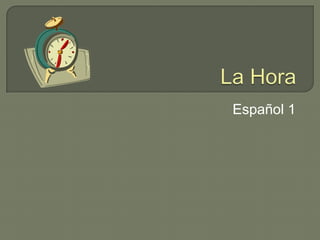
La hora
- 1. Español 1
- 2. Ser: To be What two forms of the verb do we use? Singular “es” and plural “son” You will use your numbers 1-30 when telling time.
- 3. If the time is between 12:31-1:30, you must start your time with “ES LA UNA”. (This 59 minutes is treated special!) All other times of the day will start with “SON LAS”.
- 4. The next question you have to ask yourself is, What side of the clock are the minutes on? The Spanish clock has two “minute” sides. Pretend there is a line right down the middle. The right side of the clock is known as the “y” side. (add) Minutes 01-30 sit on this side. The left side of the clock is known as the “menos” side. (subtract) Minutes 31-59 side on this side. Are you following? If not, don’t worry! In order to understand Spanish time, you have to get all the steps down.
- 5. Time: 4:10 Question 1: Is the time between 12:31 and 1:30? (NO!) Well, we need to begin our time sentence with, “Son las” then… Question 2: Are the minutes on the “y” or the “menos” side? (Y SIDE!) Okay, we start with “Son las” and then add the hour which is cuatro. So, son las cuatro… We said the minutes were on the Y side, so let’s add a y= Son las cuato Y…Now, we want to add our minute number which is diez. SO, the full sentence will look like….SON LAS CUATRO Y DIEZ. WAY TO GO!
- 6. Time: 6:40 First question to ask yourself, Is the time between 12:31 and 1:30? (NO!) So, we must start our sentence out with “SON LAS” Second question: Are the minutes on the y or menos side? 40 minutes is on the “menos” side. HERE is where it gets tricky… If the minutes are the “menos” side, you now will jump up to the next hour (so, from six to seven), and then subtract 40 from 60 minutes. Let’s try it.. Son las…siete…menos… (60-40=20) veinte. SON LAS SIETE MENOS VEINTE. This is saying, “it is seven minus twenty minutes” or, 6:40. This is the “different” part of telling time that we are not used to!
- 7. Orange arrows= up to the next hour Pink arrow= subtracting back the minutes
- 8. Time: 1:14 First question: Is the time between 12:31 and 1:30? (YES!) So, we HAVE to start our sentence with “es la una” Second question: Minutes? 14 is on the “y” side So, this will look like, “Es la una y catorce”.
- 9. ALWAYS ask yourself these two questions to figure out your pattern: 1: IS THE TIME BETWEEN 12:31 AND 1:30? (IF YES, USE ES LA UNA. IF NO, USE SON LAS) 2: ARE THE MINUTES ON THE “Y” SIDE OR THE “MENOS” SIDE?
- 10. On a separate piece of paper, try 2:05 What was your answer to the first question you should ask yourself? Son las… What was the answer to the second one? “y” side Put it together…what did you get? Hopefully…SON LAS DOS Y CINCO!
- 11. Question 1: NOT between 12:31 and 1:30, so we use SON LAS. Question 2: Minutes are on the “MENOS” side, so we have to JUMP TO NEXT HOUR AND SUBTRACT 52 FROM 60. Son las once menos ocho. (It is eleven minus 8)
- 12. Thirty= media Quarter to/quarter after= cuarto A.M.= de la manana P.M.= de la tarde/noche
- 14. 12:30 9:22 1:06 11:45 6:00 A.M. 8:18 P.M. Answers on the next slide…
- 15. Son las doce y media Son las nueve y veintidos Es la una y ocho Son las doce menos doce Son las seis de la manana Son las ocho y dieciocho de la noche How did you do?
- 16. When telling time in Spanish, always ask yourself these two questions… 1: IS THE TIME BETWEEN 12:31 AND 1:30? (IF YES, USE ES LA UNA. IF NO, USE SON LAS) 2: ARE THE MINUTES ON THE “Y” SIDE OR THE “MENOS” SIDE? Keep practicing and telling time in Spanish!
- 17. Hankin, Kaitlin. "¿Que Hora Es?" YouTube. YouTube, 24 Sept. 2011. Web. 11 May 2013. This is an original powerpoint created by Whitney Male.